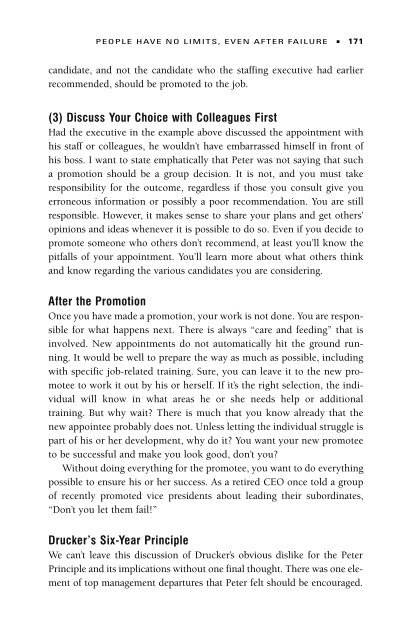A Class with Drucker - Headway | Work on yourself
A Class with Drucker - Headway | Work on yourself
A Class with Drucker - Headway | Work on yourself
You also want an ePaper? Increase the reach of your titles
YUMPU automatically turns print PDFs into web optimized ePapers that Google loves.
PEOPLE HAVE NO LIMITS, EVEN AFTER FAILURE ■ 171<br />
candidate, and not the candidate who the staffing executive had earlier<br />
recommended, should be promoted to the job.<br />
(3) Discuss Your Choice <str<strong>on</strong>g>with</str<strong>on</strong>g> Colleagues First<br />
Had the executive in the example above discussed the appointment <str<strong>on</strong>g>with</str<strong>on</strong>g><br />
his staff or colleagues, he wouldn’t have embarrassed himself in fr<strong>on</strong>t of<br />
his boss. I want to state emphatically that Peter was not saying that such<br />
a promoti<strong>on</strong> should be a group decisi<strong>on</strong>. It is not, and you must take<br />
resp<strong>on</strong>sibility for the outcome, regardless if those you c<strong>on</strong>sult give you<br />
err<strong>on</strong>eous informati<strong>on</strong> or possibly a poor recommendati<strong>on</strong>. You are still<br />
resp<strong>on</strong>sible. However, it makes sense to share your plans and get others’<br />
opini<strong>on</strong>s and ideas whenever it is possible to do so. Even if you decide to<br />
promote some<strong>on</strong>e who others d<strong>on</strong>’t recommend, at least you’ll know the<br />
pitfalls of your appointment. You’ll learn more about what others think<br />
and know regarding the various candidates you are c<strong>on</strong>sidering.<br />
After the Promoti<strong>on</strong><br />
Once you have made a promoti<strong>on</strong>, your work is not d<strong>on</strong>e. You are resp<strong>on</strong>sible<br />
for what happens next. There is always “care and feeding” that is<br />
involved. New appointments do not automatically hit the ground running.<br />
It would be well to prepare the way as much as possible, including<br />
<str<strong>on</strong>g>with</str<strong>on</strong>g> specific job-related training. Sure, you can leave it to the new promotee<br />
to work it out by his or herself. If it’s the right selecti<strong>on</strong>, the individual<br />
will know in what areas he or she needs help or additi<strong>on</strong>al<br />
training. But why wait? There is much that you know already that the<br />
new appointee probably does not. Unless letting the individual struggle is<br />
part of his or her development, why do it? You want your new promotee<br />
to be successful and make you look good, d<strong>on</strong>’t you?<br />
Without doing everything for the promotee, you want to do everything<br />
possible to ensure his or her success. As a retired CEO <strong>on</strong>ce told a group<br />
of recently promoted vice presidents about leading their subordinates,<br />
“D<strong>on</strong>’t you let them fail!”<br />
<str<strong>on</strong>g>Drucker</str<strong>on</strong>g>’s Six-Year Principle<br />
We can’t leave this discussi<strong>on</strong> of <str<strong>on</strong>g>Drucker</str<strong>on</strong>g>’s obvious dislike for the Peter<br />
Principle and its implicati<strong>on</strong>s <str<strong>on</strong>g>with</str<strong>on</strong>g>out <strong>on</strong>e final thought. There was <strong>on</strong>e element<br />
of top management departures that Peter felt should be encouraged.


